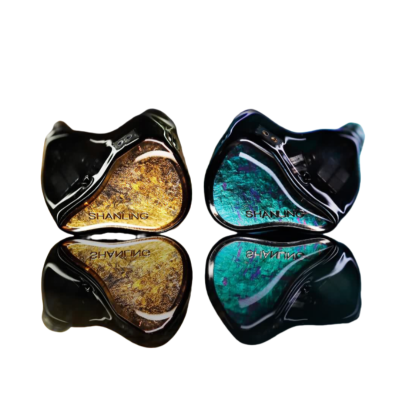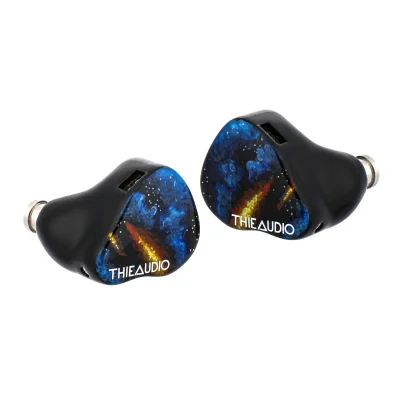Thieaudio Origin and Shanling Regal use 1DD+4BA+2EST+1BC and 2DD+4BA+2Planar driver setups respectively. Thieaudio Origin costs $849 while Shanling Regal costs $799. Thieaudio Origin is $50 more expensive. Thieaudio Origin holds a slight 0.2-point edge in reviewer scores (7.9 vs 7.8). Thieaudio Origin has significantly better bass with a 1.3-point edge, Shanling Regal has significantly better treble with a 1.6-point edge, Thieaudio Origin has significantly better dynamics with a 1.2-point edge and Shanling Regal has slightly better soundstage with a 0.4-point edge.
Insights
| Metric | Thieaudio Origin | Shanling Regal |
|---|---|---|
| Bass | 9 | 7.7 |
| Mids | 8 | 7.9 |
| Treble | 6.5 | 8.1 |
| Details | 7.9 | 8.2 |
| Soundstage | 8 | 8.4 |
| Imaging | 7.9 | 8.1 |
| Dynamics | 9 | 7.9 |
| Tonality | 8.1 | 8 |
| Technicalities | 7 | 8.1 |
Thieaudio Origin Aggregated Review Score
Average Reviewer Scores
Average Reviewer Score:
7.9Strongly Favorable
Shanling Regal Aggregated Review Score
Average Reviewer Scores
Average Reviewer Score:
7.8Strongly Favorable
Reviews Comparison
Thieaudio Origin reviewed by Web Search
The Thieaudio Origin delivers a bass-forward signature with a substantial 12dB sub-bass boost that provides visceral rumble and slam, particularly effective for electronic or hip-hop genres. Despite this emphasis, the neutral midrange avoids bloat, preserving vocal clarity and instrument separation, while the electrostatic drivers contribute a smooth, airy treble free from harshness or sibilance. Its technical performance is strong, offering a wide, holographic stage and precise imaging, though micro-detail retrieval falls slightly short of some competitors in its price tier.
Comfort is divisive due to the large shells, which may cause fatigue or fit issues for those with smaller ears, necessitating careful tip selection for optimal seal. The package includes a high-quality modular cable with swappable terminations (3.5mm/4.4mm) and a distinctive round Alcantara case, though the included ear tips may not suit all users.
Buy Thieaudio Origin on Linsoul
Ad
Price: $849
Buy Thieaudio Origin on Linsoul
Shanling Regal reviewed by Web Search
The Shanling Regal is a high-end tribrid IEM in the roughly $700–800 bracket, built around an eight-driver hybrid array of 2 dynamic drivers, 4 balanced armatures, and 2 miniature planar drivers in an opposing dual-DD layout designed to control distortion while maintaining impact. The titanium “ice crystal” faceplates and CNC-machined metal shells result in a fairly heavy but solid build, complemented by an octa-core silver-plated copper cable with interchangeable 3.5 mm and 4.4 mm plugs. Dual bass and treble switches provide four distinct sound profiles, giving the Regal more tuning flexibility than many fixed-signature competitors in this category.
In its more balanced “Atmosphere” or default-leaning settings, the Regal tends toward a neutral-warm presentation: bass has good extension and physicality from the dual 10 mm drivers, but is not pushed to overt basshead levels and stays reasonably controlled. The midrange is clear and slightly forward, giving vocals a natural focus, though some users report that upper mids and lower treble can become energetic or slightly “biting” on brighter material, particularly in the more treble-emphasized switch positions. Treble overall is described as clean and controlled with decent extension, offering enough sparkle for detail retrieval without being consistently sharp when the less aggressive tunings are selected.
On the technical side, the Regal’s combination of BA and planar drivers delivers strong resolution, precise imaging and a well-structured, moderately expansive soundstage that benefits from higher-quality sources. Detail retrieval and separation are competitive for its segment, though not dramatically ahead of some lower-priced tribrids, and the combination of shell weight and upper-mid energy in certain tunings can make long sessions fatiguing for sensitive listeners. With an official list price around the upper-midrange/entry-flagship tier, the Regal represents a versatile, technically capable option for listeners who prioritize adjustable tuning and balanced tonality over maximal bass quantity or the very highest tier of top-end refinement.
Buy Shanling Regal on Linsoul
Ad
Price: $779
Buy Shanling Regal on Linsoul
Thieaudio Origin (more reviews)
Thieaudio Origin reviewed by Z-Reviews
Youtube Video Summary
Thieaudio Origin goes full mad-science: 1DD + 4BA + 2EST + bone conductor (eight drivers per side), big shells, hefty stock cable, and a tuning built around a ~12 dB sub-bass shelf. Fit can be a touch chunky, but foam tips (think Render) lock in seal and turn the low end from “more bass somewhere” into deep, anchored slam; silicone leaves it a bit loose. Accessories are barebones—swap plugs, tips, case—and that’s it. No fancy gifts, just a box of sound.
Sonically it’s a deconstructed presentation: instead of one smooth ribbon like a single DD, the Origin spreads the band across space—drivers carving out their lanes so instruments pop up here… then there… then over there. It’s not “mushy blend,” it’s forcible separation that can feel museum-exhibit surreal: treble details flit around (hello ESTs) while bass feels omnipresent and room-filling. It doesn’t really scale with amps; neutral DAC/amps to pricier rigs all keep roughly the same character. What can change the tonality is cable impedance—at 9 Ω and high sensitivity, cheap/high-resistance wires can skew things, so stick with a stout low-impedance lead.
Gripes? The cable is thick, custom faceplates up the bill, and the package isn’t exactly a Santa sack. But for $850, the payoff is a unique, spacious, “pulled-apart” soundstage that turns playlists into set pieces. Not for purists chasing one-driver cohesion; absolutely for listeners who crave clarity, staging theatrics, and tactile bass. Final word: a solid 9/10 on sound and swagger—price keeps it off the throne, excitement keeps it in the cart.
Z-Reviews Youtube Channel
Thieaudio Origin reviewed by Jays Audio
Youtube Video Summary
Thieaudio Origin takes the “Meta” idea and dials it toward a fuller, bass-forward presentation without losing control. The bone conduction driver is not a gimmick—low notes carry palpable vibration and reverb while staying tight with clean layering and no mid bleed. Vocals sit naturally—neither shouty nor buried—though this isn’t a vocal-focused set (reach for RS5 if that’s the priority). Versus Oracle Mk II, the Origin trades some cleanliness for deeper tactility and weight, making bass textures feel more alive.
The top end is airy and extended on smooth Sonion ESTs, cutting through the warmth to balance the tuning. Most tracks are fine, but snare- and cymbal-heavy songs at higher volumes can push the treble into fatiguing territory (e.g., around 3:30 in Hikaru Utada’s “Time”). It’s generally controlled at moderate levels; just note that treble energy scales and can turn sharp when cranked.
In A/Bs, the Origin’s bass texture outclasses sets like Mega 5 EST, offering more detail, impact, and less boom. Against TITAN, Origin’s reverb and low-end “shake” edge it out while avoiding the Titan’s 5 kHz peak—though Titan still feels more exciting with livelier vocals. Versus all-rounders Monarch Mk II and Hype 10, those remain cleaner with better mids/layering but can’t match Origin’s sheer bass depth. The wildcard is BAJIE: stock, Origin wins; with EQ, BAJIE’s bigger 14.2 mm driver slams harder, while Origin stays the more balanced, tactile choice. Net: for a premium, fun, bass-centric daily driver under a grand, Origin sets a new reference—unless maximum slam with EQ is the goal.
Jays Audio Youtube Channel
Thieaudio Origin reviewed by Jaytiss
Youtube Video Summary
Thieaudio Origin brings a wild driver stack—1 DD + 4 BA + 2 EST + 1 bone conductor—inside a massive yet surprisingly comfortable shell. Build feels premium: striking faceplate, visible bone-conductor puck, proper nozzle lip, and a thicker cable than usual from the brand. The hockey-puck case is a nice touch, and for about $100 more there’s custom artwork available, making the unboxing and ownership experience feel a bit more special.
Sonically, this one swings for impact. Bass hits clean, strong, and fun, with upper mids that come across pristine. The trade-off: a hotter mid/treble band (around the 4–10 kHz region, with a notable 6 kHz glare) that can push cymbals and strings into an unnatural territory. Resolution and imaging don’t always keep pace for the price; stage is big and enveloping, but fine detail and separation can blur, making it a specialist that thrills on bass-centric tracks yet feels less convincing on metal or complex orchestral pieces.
Against its siblings, Origin sits like a more fun, bass-forward take compared with HYPE 4/10, but with a treble execution that’s less refined. Versus Oracle MK3, the latter’s ESTs sound crisper and cleaner; versus Monarch MKIII, that model’s tasteful 5–8 kHz dip lends better resolution. If pure detail is the target, sets like HiSenior Mega5 Bass or the Subtonic Annihilator may prove more satisfying. As a whole, Origin is a unique, bass-thrilled experience with excellent fit, huge space, and customization perks—great for those chasing visceral low-end and a cinematic stage, less ideal for listeners prioritizing treble finesse and microdetail at this tier.
Jaytiss Youtube Channel
Thieaudio Origin reviewed by
 Fresh Reviews
Fresh Reviews
Youtube Video Summary
Thieaudio Origin steps into the high end with a hybrid array—1DD + 4BA + 2EST + bone conduction—that pushes a richly textured, holographic presentation. The soundstage is wide and deep, imaging snaps into place, and the resolution clears the bar set by mid-tier sets. Most striking is the low-end: sub-bass digs deep with palpable rumble and impact yet avoids flooding the mix, leaving mids clean, detailed, and lifelike, and the treble airy with convincing cymbal sheen. At $850, the overall technical polish and bass quality feel appropriately premium—better than some kilobuck options.
For competitive gaming, the tuning translates across titles with ease. In Valorant, staging, separation, and distance cues deliver an A experience; occasional low-end bloom can introduce slight over/under flicks on sudden off-screen shots, but not often enough to dent performance. In Apex Legends, verticality and imaging impress (A-): during chaotic third/fourth-party fights, some lighter movement cues (slides, climbs) could cut through a bit more. In Warzone, depth and impact enhance immersion without masking key information, keeping imaging and separation strong. Tip rolling helps: foam trims bass and brightens; silicone restores slam.
Build and ergonomics match the sonic ambition: a galactic faceplate, sturdy 2-pin cable with swappable terminations, and a chassis that’s larger than average yet comfortable for long sessions (minor fatigue around the 6-hour mark). The nozzle is wide but short with a solid lip for secure tips. Overall, this is a fun yet precise set that excels in music and earns a high mark on a “wall-hack certified” style tier list for shooters—driven by standout bass, convincing staging, and top-tier separation.
Fresh Reviews original ranking
Fresh Reviews Youtube ChannelThieaudio Origin reviewed by Tim Tuned
Thieaudio Origin reviewed by Super* Review
Youtube Video Summary
At $850, Thieaudio Origin positions itself as an unapologetic bass icon with a complex driver stack (1DD/4BA/2EST plus bone conduction). Build and accessories are a mixed bag: the large, chunky shells will be too big for many ears, and the semi-transparent, pattern-heavy faceplates feel a bit generic. The thick stock cable suits the heft but the swappable plug mechanism is long, doesn’t lock, and often detaches at the adapter rather than the jack—an unnecessary annoyance. Fit is the major caveat; for smaller ears, contact is mostly at the tip, which compromises comfort and seal consistency.
Sonically, Origin is unmistakably bass-forward—well beyond Harman—with a warm, thick low end that initially reads as overbearing and soft on definition. With time, that bass takes on a distinctive, “ooey-gooey” atmospheric quality that sits under the mix rather than congesting it, enabling a surprisingly grand, spacious presentation. Above the lows, the tuning is “new-meta” adjacent: neutral-ish mids, balanced upper-treble, and a touch of mid-treble bite that sharpens transients and adds contrast. The trade-off is occasional edginess/sibilance on certain vocals, but guitars and percussion benefit from extra snap. Live recordings in particular gain scale and drama.
Against the Mega 5 EST Bass+ (cheaper, similarly boosted), Origin offers better separation and more engaging transients, while the Mega feels sludgier and less distinct—though also less edgy. Overall, Origin is a unique bass experience that prioritizes mood and scale over textbook bass tightness. The combination of fit challenges, polarizing low-end quality, and treble bite tempers enthusiasm, settling at a three-star (out of five) verdict—compelling for bass lovers seeking something different, but not a universal recommendation.
Super* Review original ranking
Super* Review Youtube ChannelThieaudio Origin reviewed by Head-Fi.org
Shanling Regal (more reviews)
Shanling Regal reviewed by Joyce's Review
Youtube Video Summary
Shanling Regal is a tri-brid in ear monitor with a shimmering faceplate, smoky transparent shell and visible drivers, backed by a solid fit that stays comfortable for four to five hour sessions. The stock package feels premium for a 699 USD set, with a refined silver plated cable, multiple tuning ear tips, SpinFit extras and a dark brown case that underlines the brand focus on small details.
In its raw tuning with switch 2 off, Regal measures and sounds very V shaped, with solid but somewhat blended bass and mids that sit a little behind the mix while upper mids stay bright, plus a dipped 7 kHz region and lifted 8 to 10 kHz band for air. Engaging switch 2 brings a clear shift: bass quantity drops slightly but keeps punch and slam, vocals move forward, separation improves and the midrange becomes cleaner, smoother and more airy, while imaging becomes very clear and treble transitions feel more natural and controlled.
Compared with a cheaper Dunu DK tribrid around 499 USD, Regal keeps a similar bass shelf but has a different presentation, with slightly more blended bass and less forward vocals, so the Dunu comes across as more vivid and stylistic while the Regal feels more balanced with switch 2 engaged. Detail retrieval, resolution and extension in the upper treble are strong, giving instruments bright but not harsh overtones and a clean, precise character that suits listeners who care more about instrument performance than lush vocals. With switch 2 on, Shanling Regal earns a solid 7.0 out of 10 as a well built, technically capable set that rewards those willing to engage its tuning options rather than use it strictly in stock form.
Joyce's Review original ranking
Joyce's Review Youtube ChannelThieaudio Origin Details
Driver Configuration: 1DD+4BA+2EST+1BC
Tuning Type: Neutral with Bass Boost, Basshead
Brand: ThieAudio Top ThieAudio IEMs
Price (Msrp): $849
Support our free service! Buying through our affiliate links costs you nothing extra:
Shanling Regal Details
Driver Configuration: 2DD+4BA+2Planar
Tuning Type: Neutral
Price (Msrp): $799
Support our free service! Buying through our affiliate links costs you nothing extra:
Thieaudio Origin User Review Score
Average User Scores
Average User Score: n/a
Based on 0 user reviews
No user reviews yet. Be the first one who writes a review!
Shanling Regal User Review Score
Average User Scores
Average User Score: n/a
Based on 0 user reviews
No user reviews yet. Be the first one who writes a review!
Thieaudio Origin Gaming Score

Gaming Score & Grade
- The gaming score is prioritizing technical capabilities of the IEM (Separation, Layering, Soundstage) and good value.
Gaming Score
7Gaming Grade
A-Shanling Regal Gaming Score

Gaming Score & Grade
- The gaming score is prioritizing technical capabilities of the IEM (Separation, Layering, Soundstage) and good value.
Gaming Score
7.6Gaming Grade
AThieaudio Origin Scorings
Average Technical & Tuning Grades
Average Tunign Grade
A+- Tuning feels refined, blending frequencies with convincing realism and engagement. Transitions between registers feel effortless.
Average Technical Grade
A-- The presentation feels orderly, balancing workable detail retrieval with acceptable imaging cues. It keeps momentum without smearing transients.
Shanling Regal Scorings
Average Technical & Tuning Grades
Average Tunign Grade
A+- Tuning feels well executed, keeping a natural flow across the spectrum. Switching genres feels seamless.
Average Technical Grade
A+- You get an articulate, polished performance with immersive stage depth and great control. There's a sense of polish across the whole spectrum.
Thieaudio Origin User Reviews
"This is an example review"
Pros
- Example pro 1
- Example pro 2
Cons
- Example con 1
- Example con 2
Share your experience and build your personal ranking list.
You need to be signed in to write your own reviewShanling Regal User Reviews
"This is an example review"
Pros
- Example pro 1
- Example pro 2
Cons
- Example con 1
- Example con 2
Share your experience and build your personal ranking list.
You need to be signed in to write your own reviewFind your next IEM:
IEM Finder Quiz
newIEM Comparison Tool
newVS



















